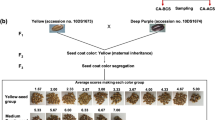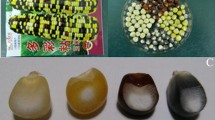Abstract
Main conclusion
In soybean, occurrence of, or tolerance to, seed cracking under low temperatures may be related to the presence or absence, respectively, of proanthocyanidin accumulation in the seed coat dorsal region.
Soybean seeds sometimes undergo cracking during low temperatures in summer. In this study, we focused on the occurrence and tolerance mechanisms of low-temperature-induced seed cracking in the sensitive yellow soybean cultivar Yukihomare and the tolerant yellow soybean breeding line Toiku 248. Yukihomare exhibited seed cracking when subjected to a 21-day low-temperature treatment from 10 days after flowering. In yellow soybeans, seed coat pigmentation is inhibited, leading to low proanthocyanidin levels in the seed coat. Proanthocyanidins accumulated on the dorsal side of the seed coat in Yukihomare under the 21-day low-temperature treatment. In addition, a straight seed coat split occurred on the dorsal side at the full-sized seed stage, resulting in seed cracking in this cultivar. Conversely, proanthocyanidin accumulation was suppressed throughout the seed coat in low-temperature-treated Toiku 248. We propose the following mechanism of seed cracking: proanthocyanidin accumulation and subsequent lignin deposition under low temperatures affects the physical properties of the seed coat, making it more prone to splitting. Further analyses uncovered differences in the physical properties of the seed coat between Yukihomare and Toiku 248. In particular, seed coat hardness decreased in Yukihomare, but not in Toiku 248, under the low-temperature treatment. Seed coat flexibility was higher in Toiku 248 than in Yukihomare under the low-temperature treatment, suggesting that the seed coat of low-temperature-treated Toiku 248 is more flexible than that of low-temperature-treated Yukihomare. These physical properties of the Toiku 248 seed coat observed under low-temperature conditions may contribute to its seed-cracking tolerance.










Similar content being viewed by others
Abbreviations
- CD:
-
Cold-induced seed coat discoloration
- CHS:
-
Chalcone synthase
- DMACA:
-
4-Dimethylaminocinnamaldehyde
- dNS:
-
Developing non-SC seeds
- dSS:
-
Developing SC seeds
- PA:
-
Proanthocyanidin
- QTL:
-
Quantitative trait locus
- SC:
-
Seed cracking
- THM:
-
Seed coat pigmented mutant of cv. Toyohomare
- T248:
-
Breeding line Toiku 248
- YH:
-
cv. Yukihomare
References
Barros J, Serk H, Granlund I, Pesquet E (2015) The cell biology of lignification in higher plants. Ann Bot 115:1053–1074
Bernard RL, Weiss MG (1973) Qualitative genetics. In: Caldwell BE (ed) Soybean: Improvement, production, and uses. American Society of Agronomy, Madison, pp 117–154
Delessert C, Wilson I, Van Der Straeten D, Dennis E, Dolferus R (2004) Spatial and temporal expression of the local response to wounding. Plant Mol Biol 55:165–181
Funatsuki H, Ohnishi S (2009) Recent advances in physiological and genetic studies on chilling tolerance in soybean. JARQ Jpn Agric Res Q 43:95–101
Kasai A, Kasai K, Yumoto S, Senda M (2007) Structural features of GmIRCHS, candidate of the I gene inhibiting seed coat pigmentation in soybean: implications for inducing endogenous RNA silencing of chalcone synthase genes. Plant Mol Biol 64:467–479
Kasai A, Ohnishi S, Yamazaki H, Funatsuki H, Kurauchi T, Matsumoto T, Yumoto S, Senda M (2009) Molecular mechanism of seed coat discoloration induced by low temperature in yellow soybean. Plant Cell Physiol 50:1090–1098
Kim YJ, Kim DG, Lee SH, Lee I (2006) Wound-induced expression of the ferulate 5-hydroxylase gene in Camptotheca acuminata. Biochim Biophys Acta 1760:182–190
Kurauchi T, Kasai A, Tougou M, Senda M (2011) Endogenous RNA interference of chalcone synthase genes in soybean: formation of double-stranded RNA of GmIRCHS transcripts and structure of the 5′ and 3′ ends of short interfering RNAs. J Plant Physiol 168:1264–1270
Liang M, Davis E, Gardner D, Cai X, Wu Y (2006) Involvement of AtLAC15 in lignin synthesis in seeds and in root elongation of Arabidopsis. Planta 224:1185–1196
Liu HL (1949) Inheritance of defective seed coat in soybeans. J Hered 40:317–322
Morrison MJ, Pietrzak LN, Voldeng HD (1998) Soybean seed coat discoloration in cool-season climates. Agron J 90:471–474
Nicholas CD, Lindstrom JT, Vodkin LO (1993) Variation of proline rich cell wall proteins in soybean lines with anthocyanin mutations. Plant Mol Biol 21:145–156
Ohnishi S, Funatsuki H, Kasai A, Kurauchi T, Yamaguchi N, Takeuchi T, Yamazaki H, Kurosaki H, Shirai S, Miyoshi T, Horita H, Senda M (2011) Variation of GmIRCHS (Glycine max inverted-repeat CHS pseudogene) is related to tolerance of low temperature-induced seed discoloration in yellow soybean. Theor Appl Genet 122:633–642
Percy JD, Philip R, Vodkin LO (1999) A defective seed coat pattern (Net) is correlated with the post-transcriptional abundance of soluble proline-rich cell wall proteins. Plant Mol Biol 40:603–613
Qutob D, Ma F, Peterson CA, Bernards MA, Gijzen M (2008) Structural and permeability properties of the soybean seed coat. Botany 86:219–227
Ritchie SW, Hanway JJ, Thompson HE, Benson GO (1985) How a soybean plant develops. Special Report No. 53. Iowa State University of Science and Technology Cooperative Extension Service, Ames
Senda M, Masuta C, Ohnishi S, Goto K, Kasai A, Sano T, Hong JS, MacFarlane S (2004) Patterning of virus-infected Glycine max seed coat is associated with suppression of endogenous silencing of chalcone synthase genes. Plant Cell 16:807–818
Senda M, Kurauchi T, Kasai A, Ohnishi S (2012) Suppressive mechanism of seed coat pigmentation in yellow soybean. Breed Sci 61:523–530
Senda M, Yamaguchi N, Hiraoka M, Kawada S, Iiyoshi R, Yamashita K, Sonoki T, Maeda H, Kawasaki M (2017) Accumulation of proanthocyanidins and/or lignin deposition in buff-pigmented soybean seed coats may lead to frequent defective cracking. Planta 245:659–670
Shaipulah NFM, Muhlemann JK, Woodworth BD, Moerkercke AV, Verdonk JC, Ramirez AA, Haring MA, Dudareva N, Shuurink RC (2016) CCoAOMT down-regulation activates anthocyanin biosynthesis in petunia. Plant Physiol 170:717–731
Soltani BM, Ehlting J, Hamberger B, Douglas CJ (2006) Multiple cis-regulatory elements regulate distinct and complex patterns of developmental and wound-induced expression of Arabidopsis thaliana 4CL gene family members. Planta 224:1226–1238
Srinivasan A, Arihara J (1994) Soybean seed discoloration and cracking in response to low temperatures during early reproductive growth. Crop Sci 34:1611–1617
Stewart RT, Wentz JB (1930) A defective seed-coat character in soybeans. J Am Soc Agron 22:658–662
Szittya G, Silhavy D, Molnár A, Havelda Z, Lovas Á, Lakatos L, Bánfalvi Z, Burgyán J (2003) Low temperature inhibits RNA silencing-mediated defence by the control of siRNA generation. EMBO J 22:633–640
Takahashi R, Abe J (1994) Genetic and linkage analysis of low temperature-induced browning in soybean seed coats. J Hered 85:447–450
Takahashi R, Abe J (1999) Soybean maturity genes associated with seed coat pigmentation and cracking in response to low temperatures. Crop Sci 39:1657–1662
Todd JJ, Vodkin LO (1993) Pigmented soybean (Glycine max) seed coats accumulate proanthocyanidins during development. Plant Physiol 102:663–670
Tuteja JH, Clough SJ, Chan W-C, Vodkin LO (2004) Tissue-specific gene silencing mediated by a naturally occurring chalcone synthase gene cluster in Glycine max. Plant Cell 16:819–835
Yamaguchi N, Yamazaki H, Ohnishi S, Suzuki C, Hagihara S, Miyoshi T, Senda M (2014) Method for selection of soybeans tolerant to seed cracking under chilling temperatures. Breed Sci 64:103–108
Yamaguchi N, Taguchi-Shiobara F, Sayama T, Miyoshi T, Kawasaki M, Ishimoto M, Senda M (2015) Quantitative trait loci associated with tolerance to seed cracking under chilling temperature in soybean. Crop Sci 55:2100–2107
Zabala G, Vodkin L (2003) Cloning of the pleiotropic T locus in soybean and two recessive alleles that differentially affect structure and expression of the encoded flavonoid 3′ hydroxylase. Genetics 163:295–309
Acknowledgements
This work was supported by the Ministry of Agriculture, Forestry, and Fisheries of Japan [Genomics-based Technology for Agricultural Improvement, SFC1006 (to MS, MK, HM, and NY)] and the Japan Society for the Promotion of Science [KAKENHI, grant number 15K07268 (to MS)]. We thank Jennifer Smith, PhD, Emma Tacken, Ph.D., and Barbara Goodson, PhD from Edanz Group (http://www.edanzediting.com/ac) for editing a draft of this manuscript.
Author information
Authors and Affiliations
Corresponding author
Ethics declarations
Conflict of interest
Authors declare that they have no conflict of interest.
Electronic supplementary material
Below is the link to the electronic supplementary material.
Supplemental Fig. S1
Cross sections of seed coats of YH and T248 grown under normal conditions (YH-N and T248-N, respectively). Seed coat sections were stained with DMACA to show PA accumulation. a YH-N (hilum region), b YH-N (middle region), c YH-N (dorsal region), d T248-N (hilum region), e T248-N (middle region), f T248-N (dorsal region). Hilum, middle, and dorsal regions are shown in Fig. 2e. pa, parenchyma; pl, palisade layer; tb, tracheid bar. Scale bars 100 μm (a, d) and 20 μm (b, c, e, f) (PPTX 11174 kb)
Supplemental Fig. S2
Comparison of seed coat physical properties among YH-N, YH-L dNS, and YH-L dSS. Vertical bars represent mean ± SD [n = 51 for YH-N, n = 29 for YH-L (dNS), and n = 22 for YH-L (dSS)]. Different letters indicate significant differences at P < 0.05 by Tukey–Kramer’s test (PPTX 43 kb)
Rights and permissions
About this article
Cite this article
Senda, M., Kawasaki, M., Hiraoka, M. et al. Occurrence and tolerance mechanisms of seed cracking under low temperatures in soybean (Glycine max). Planta 248, 369–379 (2018). https://doi.org/10.1007/s00425-018-2912-z
Received:
Accepted:
Published:
Issue Date:
DOI: https://doi.org/10.1007/s00425-018-2912-z




